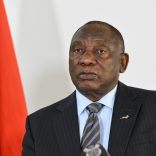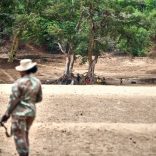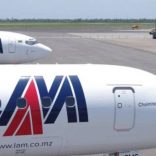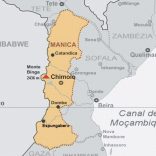South Africa seeks new US trade deal after tariff hike, says presidency
Botswana: Losing drugs battle

File photo
Botswana is losing the battle against illegal drugs trade with official police statistics showing that dagga, cocaine and heroin’s abuse has entered alarming levels. Statistics from Drugs and Narcotics Division of Botswana police shows a growing number of cases and variety of drugs, which have been detected or intercepted within the borders and at the ports of entry. Dagga remains the most abused illegal drug in Botswana due to its easy availability. Cocaine is second placed among abused drugs with rock or crack cocaine being the most abused. Other drugs include Ecstasy and Alcohol. Deputy Officer Commanding Narcotics, Fauna and Flora Investigations Detective Superintendent, Albert John Morapedi concedes that the rising detection statistics is a clear indication that drugs have become a serious problem.
He says more cases are being recorded because of concerted efforts between his division and other stakeholders in the fight against illegal drugs. Morapedi stops short of admitting that they are fighting a losing battle against proliferation of drugs. He says the biggest drug centres are major cities and towns like Gaborone, Francistown and Maun where the use of hard drugs is on the increase. Most of the drug users are the youth, including even school going kids who either supply their peers or bring drugs to school to share, he says. This causes major disruptions in learning as students high on drugs become disorderly and cannot concentrate during lessons. Some students have even been referred to Sbrana Psychiatric Hospital after capitulating under a mental breakdown. He calls for more preventative measures, where family members should detect any suspicion of drug use among their siblings and peers. “Hawkers, street vendors and car wash businesses have become major points of sale for drugs on the streets,” says Morapedi.
o
Reports compiled by the police over the years show a growing number of nationalities arrested in connection with the growing variety of drugs detected in Botswana. Although Batswana dominate, there is a growing number of Zimbabweans, Zambians, South Africans and Tanzanians arrested in connection with the more potent hard drugs. Some 565 cases of possession of dagga were recorded in 2013 with total weight of 1 381.36 kg. Of the 860 suspects arrested in connection with the cases 823 were Batswana, 21 Zimbabweans, five Zambians, four from Swaziland and three South Africans. The rest were from Britain, Chile and Bulgaria. A Somalia national and 21 Batswana were arrested in connection with 13 cases of cocaine weighing 1. 619 kg. Yet more arrests were made for seven (7) cases of ephedrine weighing 143.819 kg, which included four (4) Batswana and three (3) Zimbabweans.
Some 639 cases of dagga weighing a total 359.2 kg were recorded in 2014 where 870 suspects were arrested. Of these, 837 were Batswana, 17 Zimbabweans, five Swazis, four South Africans and Zambians respectively, two Namibians and one Mozambican. In the same year 19 Batswana were arrested in connection with 12 cases of cocaine, weighing a total 146.9148 grams. A Mozambican, a Zambian and a South African were arrested in connection with three cases of ephedrine weighing 47.9615 kg. One case of heroin weighing four kilogram was recorded leading to the arrest of one Tanzanian, one Zimbabwean and a Motswana. Some 652 cases of dagga weighing 253.632 kg were recorded in 2015 with 779 suspects arrested. Of these, 732 were Batswana, 16 Zimbabweans, 13 Zambians, nine South Africans, six Swazis and three Namibians. For the same period 22 Batswana were arrested in connection with 18 cases of cocaine recorded, weighing 188.5 grams. A new drug, Meth-cathinone (CAT) made its debut with 14 cases, weighing 130.89 grams where 27 suspects (25 Batswana, one South African and one Zimbabwean) were arrested. Three cases of heroin weighing 201.4699 grams were recorded leading to six arrests of two Batswana, one Kenyan and three Tanzanians.
In Q1 2016 (January to March), 158 cases of dagga weighing 103.936 kg have already been recorded where 305 were arrested. These were 298 Batswana, 4 Zimbabweans, 2 Swazis and a South African. Two suspects (a Motswana and a Zimbabwean) have already been arrested in connection with (2) cases of cocaine, weighing 8.1033 grams. Six Tanzanians have already been arrested in connection with five cases of heroin weighing 8790.1 grams. Morapedi says although statistics show small quantities of hard drugs intercepted, it is a clear indicator that there are some users in the country while some of the arrests were on suspects in transit to neighbouring South Africa. He says the increase could be a testimony that their collaborative efforts are bearing fruit, leading to increasing detection. “It could well be that Botswana is used by drug dealers in transit to the more sophisticated and lucrative market in South Africa. Ephedrine pills are known to be used to manufacture other street drugs often found in SA, which we have not detected in Botswana,” he says.
Security at ports of entry
A Botswana Unified Revenue Services (BURS) official says they monitor the entry and departure of goods, and prevent the use of local ports of entry for illicit goods including drugs. She says they work with the army, intelligence and security organs and the police in their operations, with narcotics and drugs division of the police focusing on illicit drugs. Morapedi confirms that they collaborate with airlines, BURS and other intelligence organs to prevent entry of drugs into the country. He said although there are scanners at some borders they are not in all ports of entry. Even sniffer dogs used in tracing drugs are not permanently resident at the ports of entry but are only deployed on assignment when the need arises. He is, therefore, quick to admit that they are seriously under resourced to man the borders 24 hours round the clock.
BURS response
BURS spokesperson Refilwe Moonwa said they are not in a position to comment on the recent drug bust at Tlokweng border, as there is a possibility of them assisting in the on-going judicial process. Although she assured Batswana that BURS shall leave no stone unturned in an endeavour to manage borders for the development and security of people, Moonwa conceded that, at times, some criminals may find their way through the system. “BURS, together with other border agencies, is concerned with smuggling of prohibited drugs through and into Botswana and have put in place measures aimed dealing with the challenge. Through the strategies that have been put in place at Botswana’s border posts and airports by Border Agencies to deal with the challenge, a number of persons have been intercepted attempting to smuggle drugs into Botswana and some of the people have been subjected to prosecution whilst others are under investigations,” she said. Moongwa said in order enhance the national enforcement strategy that has led to the interception of prohibited drugs at Botswana’s border posts and airports in the past, BURS is currently working on establishing an operational detector dog unit to provide a non-intrusive search and detection capability at Botswana’s ports of entry to assist in the prevention and detection of smuggling of contraband such as drugs (e.g. marijuana, mandrax, heroin, cocaine, LSD, ecstasy and all other narcotics).
Hawks beating DISS in drug busts
Morapedi was at a loss trying to explain how a truck carrying drugs estimated at about R80 million recently drove through the country and exited at the Tlokweng border undetected. In April 2016 South African Revenue Service (SARS) officers arrested two foreign nationals for drug smuggling when an empty truck was stopped for routine inspection at the border after driving through Botswana undetected. SARS custom officials confiscated drugs to the value of almost R80 million at the Kopfontein border post with Botswana in North West. The customs detector dogs reacted positively to narcotics. It was found the truck had false compartments to stash away 141 packages of Mandrax. Thus 1 428.140 tablets worth R78 547 700 were confiscated. The two men, truck, and tablets were handed over to the South African Police Service, SARS said.
OR Tambo hub; leads in busts
Recently the South African media has been awash with reports of drug busts done almost weekly, particularly at OR Tambo International Airport in Johannesburg, which also serves as an alternate airport for Sir Seretse Khama International Airport. SA police say despite the frequency of the arrests the number of people trying to smuggle drugs has not decreased. Customs officials at OR Tambo recently intercepted a man who claimed an unaccompanied bag from Dar es Salaam in Tanzania containing 20kg of ephedrine. The seized ephedrine’ a key ingredient in the manufacturing of tik’ was estimated to be worth R6m. The interception followed collaborative efforts between SARS’ airline officials and the police. On March 21, 2016 police at OR Tambo International Airport (ORTIA) arrested a 47 year old woman attempting to smuggle R10 million worth of crystal meth into the country. The South African woman arrived at OR Tambo from Accra, Ghana on a South African Airways flight at 6:20 am. Last week, another unclaimed bag from India was discovered at OR Tambo International Airport. The bag contained R8 million worth of crystal meth.
The latest drug bust netted 25kg of tik (crystal methamphetamine) valued at R7.5-million on Friday night, May 27. SARS customs officials made the seizure during an inspection of a flight from Cotonou in Benin’ West Africa. SARS spokesman Sandile Memela was quoted saying “All unaccompanied bags were escorted to the SARS customs search area for scanning (and) 25 plastic bags containing a white substance were found in one of the bags. The substance tested positive for crystal methamphetamine weighing 25.2kg with a street value of R7’560’000”. On Friday last week’ customs officials found a bag containing tik worth R8-million. It had been sent unaccompanied from India via Abu Dhabi. The previous day’ a male passenger from Sao Paulo in Brazil was intercepted carrying 8.4kg of cocaine valued at R2.341-million. The man was on his way to Mozambique.
International Air Transport Association (IATA), which represents some 260 airlines comprising 83% of global air traffic, recently called for closer collaboration with governments to improve security at the airports. The IATA 72nd Annual General Meeting (AGM) that took place in Dublin, Ireland unanimously adopted a resolution that calls for intensified cooperation among governments as well as with the air transport industry to keep flying secure. Tony Tyler, IATA’s Director General and CEO called for commitment of all possible government resources, particularly intelligence resources, to fighting the use of aviation for terrorist acts. “Intelligence is the most powerful tool that governments have to protect their citizens wherever they are–at work, in their homes or while traveling,” said Tyler.












Leave a Reply
Be the First to Comment!
You must be logged in to post a comment.
You must be logged in to post a comment.